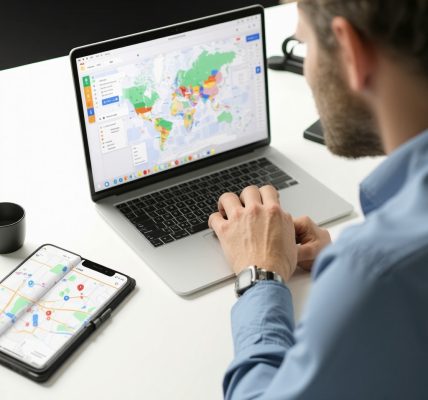Boosting Your Google Maps Traffic with SEO Strategies
In today’s digital age, attracting customers through online visibility is crucial for businesses. Google Maps has become a vital tool for local businesses to enhance their presence and reach potential customers. To effectively improve your Google Maps traffic, implementing strong SEO strategies is essential. This guide will explore effective tips to elevate your Google Maps rankings and drive organic traffic to your business.
Understanding Google Maps SEO
Google Maps SEO refers to optimizing your business listing on Google Maps to enhance visibility when users search for local services or products. By focusing on local search engine optimization (SEO), businesses can increase their chances of appearing in the coveted Local Pack, which showcases top businesses related to a user’s query. This is particularly important as studies show that nearly 78% of mobile local searches result in an offline purchase.
Optimize Your Google Business Profile
One of the first steps in improving your Google Maps traffic is to ensure that your Google Business Profile is fully optimized. This includes providing accurate and complete information about your business, such as your name, address, and phone number (NAP). Ensure your NAP is consistent across all online platforms to avoid confusion and improve local SEO.
Additionally, choose the most relevant categories for your business. Selecting appropriate categories helps Google understand your business and match it with relevant searches. Don’t forget to add a detailed business description that includes important keywords that potential customers might use to find your services.
Leverage Customer Reviews for Enhanced Visibility
Customer reviews play a significant role in influencing potential customers and boosting your Google Maps ranking. Encourage satisfied customers to leave positive reviews on your Google Business Profile. A higher number of positive reviews can enhance your credibility and increase your business visibility in search results.
Moreover, responding to reviews—both positive and negative—demonstrates your commitment to customer satisfaction and can encourage more engagement. For best practices on managing reviews, check out our guide on GMB review generation best practices.
Utilize Local Keywords Strategically
Incorporating local keywords into your content strategy is crucial for targeting your audience effectively. Use tools like Google Keyword Planner or SEMrush to identify relevant local keywords that align with your business offerings. By integrating these keywords into your Google Business Profile, website content, and blog posts, you enhance your chances of ranking higher in local search results.
For example, if you run a coffee shop in Brooklyn, using keywords like “best coffee shop in Brooklyn” can help connect your business with local customers searching for coffee options in their vicinity. To delve deeper into local SEO techniques, consider reading our comprehensive guide on local SEO optimization techniques.
Engaging with Your Local Community
Building a strong connection with your local community can significantly enhance your Google Maps visibility. Participating in community events, sponsoring local activities, or collaborating with other local businesses can foster goodwill and generate word-of-mouth referrals. This grassroots approach not only boosts your presence in the community but can also lead to increased online engagement and reviews, further enhancing your business’s credibility.
Implementing Local SEO Best Practices
To maximize your Google Maps traffic, it’s essential to implement local SEO best practices consistently. Start by ensuring your website is optimized for mobile devices, given that a significant portion of local searches occur on smartphones. A mobile-friendly site improves user experience and can lead to higher conversion rates. For more insights on optimizing your site, check out our guide on essential tools for Google Business SEO.
Additionally, consider creating location-specific landing pages that detail your services tailored to different areas you serve. This strategy enhances relevance for local searches and can help you appear in more specific search queries. Using local landmarks and community references can also help you connect with your audience.
Maximizing Google My Business Features
Your Google My Business (GMB) profile offers various features that can optimize your listing. Utilize the post feature to share updates, promotions, or events. Regularly posting relevant content not only engages your audience but also signals to Google that your business is active, which can positively impact your search rankings. For effective strategies on maintaining your GMB profile, explore our post on weekly GMB posting services.
Building Quality Backlinks
Backlinks remain a critical component of SEO, including for Google Maps rankings. Invest time in developing quality backlinks from reputable local websites, such as local news outlets, industry-related blogs, and community organizations. These links not only enhance your site’s authority but also drive referral traffic directly to your Google Business Profile.
Utilize outreach strategies, such as guest blogging or offering to write testimonials for local businesses, to create valuable backlinks. For detailed backlink strategies, review our guide on GMB backlink building strategies.
Monitoring Your Performance and Making Adjustments
Finally, regularly monitor your Google Maps performance using tools like Google Analytics and Google Search Console. These tools can provide invaluable insights into how users interact with your GMB listing and track your ranking progress. By analyzing this data, you can identify areas for improvement and adjust your strategies accordingly. For a comprehensive approach to tracking your SEO performance, refer to our article on GMB SEO audit checklist.
Enhancing Your Google Maps Visibility with Strategic Practices
To further enhance your Google Maps visibility, it’s crucial to engage in strategic practices that set your business apart. One effective method is to utilize localized content marketing. By creating content that resonates with your community, you not only improve your chances of ranking higher but also foster a connection with potential customers. Consider writing blog posts about local events, partnerships, or community contributions. This kind of content can be shared on your Google Business Profile and social media channels, driving more traffic back to your listing.
Utilizing Google My Business Insights
Google My Business provides valuable insights that can inform your marketing strategies. By regularly checking your GMB Insights, you can learn how customers find your business, what actions they take, and other essential metrics. This data can guide your decisions on where to focus your efforts. For example, if you notice that most customers are discovering your business through direct searches, you might want to invest more time in building your brand recognition through offline marketing and community engagement.
Optimizing Photos and Videos for Local Engagement
Visual content is a key factor in engaging potential customers. High-quality photos and videos of your business can significantly impact your Google Maps ranking and user engagement. Ensure you regularly update your media to reflect your current offerings and atmosphere. Photos that showcase your products, services, and even staff can create a personal connection with potential customers. Moreover, consider utilizing GMB photo optimization tips to ensure your images are optimized for search engines.
Implementing a Local Link Building Strategy
Building local backlinks is another effective tactic for improving your Google Maps ranking. Collaborate with local businesses, sponsors, or community events to generate links back to your Google Business Profile. By being featured on local news sites or blogs, you can enhance your site’s authority and visibility. Utilize outreach strategies like guest blogging on local websites or sponsoring community events to create valuable connections and backlinks. For more insights, explore our guide on GMB backlink building strategies.
Engaging Through Social Media and Email Marketing
Social media platforms are powerful tools for driving traffic to your Google Maps listing. Regularly posting engaging content, promotions, and customer testimonials can attract followers and encourage them to visit your business. Moreover, implementing email marketing campaigns that highlight special offers or local events can keep your audience informed and engaged. Ensure that your email campaigns link back to your Google Business Profile to capitalize on interested customers.
Tracking Competitors and Their Strategies
Understanding your competitors can provide valuable insights into what strategies are effective in your niche. Regularly analyze their Google Business Profiles to see what they are doing well and where there might be gaps you can exploit. Look for trends in their customer reviews, the types of posts they share, and how they engage with their audience. Adapting successful elements to your strategy can give you an edge in local search visibility.
As you implement these advanced strategies, keep in mind that the local SEO landscape is constantly evolving. Staying informed about the latest trends and updates in Google My Business can help you maintain a competitive edge in your market. The next step involves diving deeper into specific tactics that can further elevate your Google Maps presence.
Advanced Strategies to Enhance Your Google Maps Visibility
To stand out in the competitive landscape of Google Maps, employing advanced strategies can significantly boost your visibility and traffic. One effective approach is to leverage local partnerships and collaborations with other businesses. By teaming up with complementary local businesses for joint promotions or events, you can tap into each other’s customer bases, creating a win-win situation. These collaborations not only boost your network but also enhance your local SEO through shared backlinks and increased engagement.
Utilizing Local Events for Marketing Opportunities
Participating in or sponsoring local events can be a game changer for your Google Maps visibility. Events like fairs, markets, or community gatherings offer excellent opportunities to showcase your business directly to potential customers. Ensure you promote your participation on your Google Business Profile and through social media channels. By doing so, you can attract local attendees and direct them to your listings, enhancing traffic and engagement.
Creating Unique Content for Local Audiences
Content marketing tailored to your local audience is another effective strategy. Consider writing blog posts or creating videos that highlight local stories, events, or businesses. This localized content not only fosters community connection but also improves SEO by integrating relevant local keywords. For instance, if your business is located in a neighborhood known for its history, creating content that discusses local historical landmarks can attract interest and traffic. To learn more about effective content strategies, check out our guide on keeping your listings fresh.
Implementing Structured Data Markup
Structured data markup is a powerful tool that can enhance your Google Maps listing. By implementing schema markup on your website, you can provide search engines with specific information about your business, such as location, hours of operation, and services offered. This structured data can enhance your visibility in search results and improve your chances of appearing in the local pack. For more insights on how to effectively use structured data, refer to our article on essential SEO tools.
Encouraging User-Generated Content
Encouraging user-generated content (UGC) is an excellent way to build community and improve your local SEO. Invite customers to share their experiences through photos, videos, or testimonials on your Google Business Profile and social media. This type of content not only enriches your online presence but also builds trust among potential customers. Consider running a contest or incentive program that encourages customers to share their experiences, driving engagement and visibility.
Regularly Updating Your Google Business Profile
To maintain high visibility on Google Maps, it’s crucial to keep your Google Business Profile updated consistently. Regular updates about your services, new products, or promotions signal to Google that your business is active and engaged. This consistent activity can positively influence your search rankings. For detailed strategies on managing your profile, explore our guide on transforming your GMB profile.
Analyzing and Adapting Your Strategies
Lastly, continuously analyze your performance on Google Maps and adapt your strategies accordingly. Utilize tools like Google Analytics and Google My Business Insights to track user engagement and identify which tactics are yielding the best results. By understanding your audience’s behavior and preferences, you can refine your approach to meet their needs more effectively. For an in-depth look at performance monitoring, check out our guide on GMB SEO audit checklist.
Frequently Asked Questions (FAQs)
1. What is the best way to optimize my Google Business Profile for local searches?
To optimize your Google Business Profile for local searches, ensure that your name, address, and phone number (NAP) are accurate and consistent across all platforms. Choose relevant categories, add a comprehensive business description with local keywords, and regularly update your profile with posts and promotions.
2. How do customer reviews impact my Google Maps ranking?
Customer reviews significantly influence your Google Maps ranking. A higher number of positive reviews can enhance your credibility and visibility in search results. Encourage satisfied customers to leave reviews and actively respond to them to show engagement.
3. How can I find the right local keywords for my business?
Utilize keyword research tools like Google Keyword Planner or SEMrush to identify local keywords that align with your business offerings. Focus on terms that your target audience is likely to search for, including location-specific phrases.
4. What role does mobile optimization play in Google Maps SEO?
Mobile optimization is crucial as many local searches are conducted on smartphones. A mobile-friendly website enhances user experience, leading to higher engagement and conversion rates, which can positively impact your Google Maps ranking.
5. How often should I update my Google Business Profile?
Regular updates are essential to maintain visibility on Google Maps. Update your profile with new services, promotions, and posts frequently to signal to Google that your business is active and engaged.
6. What are the benefits of using local backlinks for my Google Maps strategy?
Local backlinks enhance your website’s authority and boost your Google Maps ranking. Collaborating with local businesses and community organizations can help generate valuable backlinks that drive referral traffic to your Google Business Profile.
7. How can social media impact my Google Maps visibility?
Social media can drive traffic to your Google Maps listing by promoting your business, sharing customer testimonials, and engaging with your audience. Linking your social media posts to your Google Business Profile can increase visibility and attract potential customers.
8. What kind of content should I create for local SEO?
Create content that resonates with your local audience, such as blog posts about local events, partnerships, or community initiatives. This localized content can improve your SEO by integrating relevant local keywords and fostering community connections.
9. How can I analyze my Google Maps performance?
Utilize tools like Google Analytics and Google My Business Insights to track user engagement and performance. These tools provide valuable data on how customers find and interact with your business, helping you refine your strategies.
10. What are structured data markup and its benefits for Google Maps?
Structured data markup helps search engines understand your business information, such as location and services. By implementing schema markup, you can enhance your visibility in search results and improve your chances of appearing in the local pack.
Authority Resources
For further reading and to deepen your understanding of Google Maps SEO, consider exploring the following trusted resources:
- Moz – Comprehensive guides and tools for SEO strategies and best practices.
- Ahrefs Blog – Insights on SEO, keyword research, and backlinking strategies.
- Neil Patel – Expert advice on digital marketing and SEO techniques.
- Search Engine Land – Latest news and insights in search marketing.
- Search Engine Journal – Articles and guides on SEO, PPC, and content marketing.
- Google My Business Help – Official resources and support for optimizing your Google Business Profile.
Conclusion
In conclusion, enhancing your Google Maps visibility requires a combination of strategic practices, local SEO techniques, and community engagement. By optimizing your Google Business Profile, leveraging customer reviews, utilizing local keywords, and creating valuable content, you can significantly improve your local search rankings. Remember that the landscape of local SEO is ever-evolving, so staying informed about best practices and implementing advanced strategies will ensure your business remains competitive in attracting local customers. By following the guidelines outlined in this comprehensive article, you can maximize your Google Maps traffic and ultimately drive more customers to your business.



The importance of keeping your Google Business Profile consistently updated really stood out to me. In my experience managing a local bakery, regularly updating photos and posting about seasonal promotions not only helped keep our listing fresh but also noticeably increased foot traffic. I’ve also seen the benefit of encouraging customers to leave reviews by gently reminding them through in-store signage and follow-up emails. However, one challenge I’ve encountered is ensuring the accuracy and consistency of our business information across multiple platforms, especially with phone numbers and addresses. Has anyone found effective tools or workflows to streamline verifying and updating NAP information to maintain consistency without it becoming too time-consuming? I’m curious how others balance the need for frequent updates with limited resources, particularly for small businesses striving to improve their Google Maps visibility.